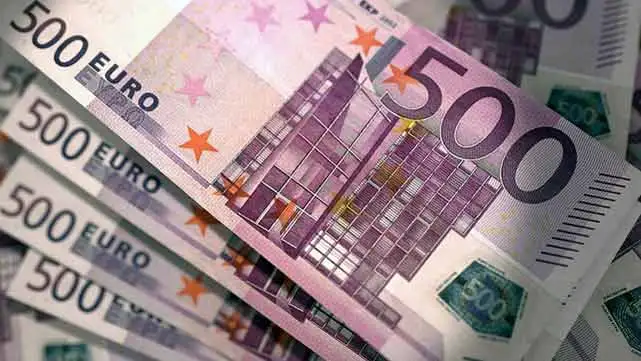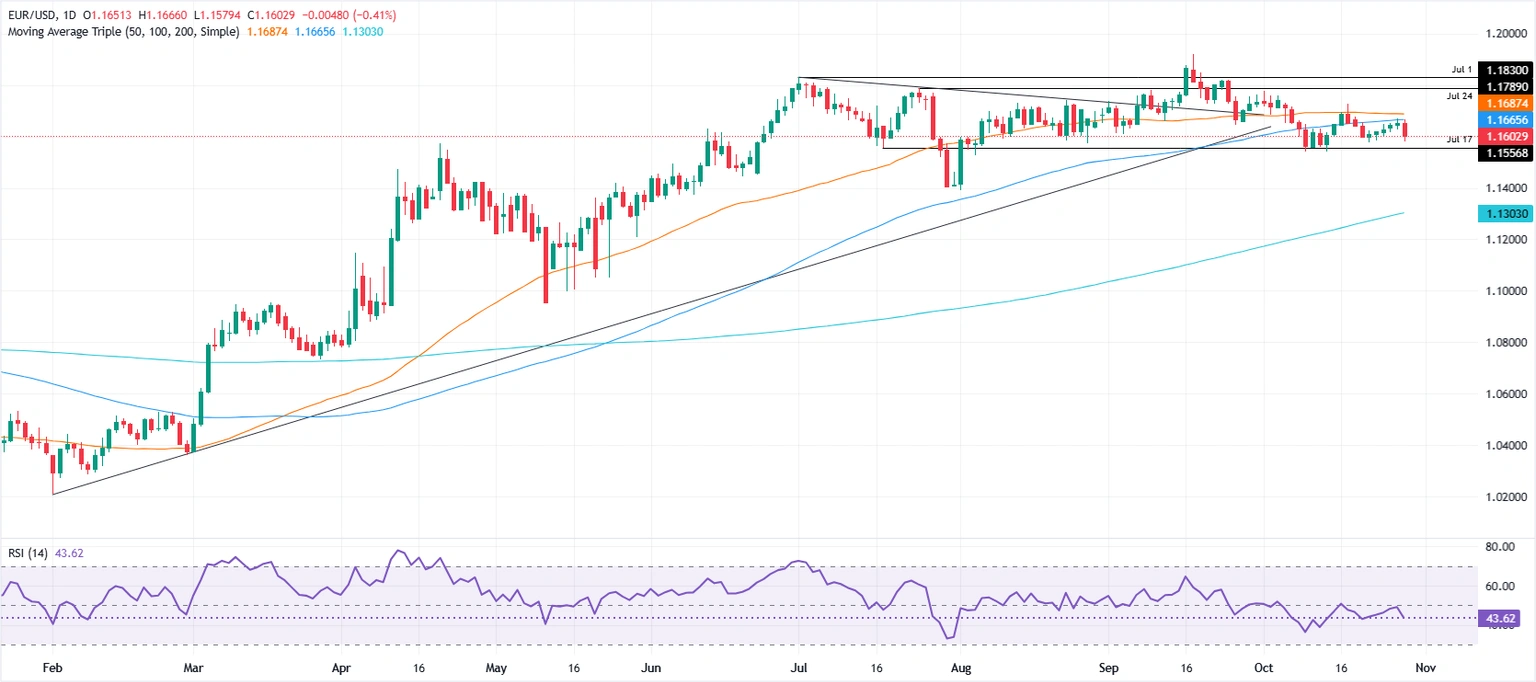Key Takeaways
- The EUR/USD currency pair saw a significant drop following the Federal Reserve’s recent policy announcement and Chair Jerome Powell’s remarks.
- Powell signaled that a December interest rate cut is not a certainty, leading to a hawkish interpretation of the Fed’s stance and a stronger US dollar.
- The US Dollar Index (DXY) rose, reflecting the strengthening dollar against major currencies.
- Market participants are now anticipating the European Central Bank’s (ECB) upcoming monetary policy decision.
- Technical analysis indicates a bearish trend for EUR/USD, with key support levels being closely watched.
EUR/USD Declines Sharply Post-Federal Reserve Announcement
The EUR/USD currency exchange rate experienced a significant decline of over 0.43% on Wednesday. This market movement followed the conclusion of the Federal Reserve’s meeting and public statements from Federal Reserve Chair Jerome Powell, which were widely interpreted as hawkish. Powell’s comments suggested that a rate cut in December is not guaranteed, dampening expectations for immediate monetary easing by the central bank.
At the time of reporting, the EUR/USD pair was trading near its weekly low, specifically around the 1.1601 mark. Traders are now closely observing the monthly low of 1.1542 as a potential next target for the currency pair.
Federal Reserve’s Hawkish Stance Sways Market Sentiment
Following the Federal Reserve’s meeting, Jerome Powell’s statement that a reduction in interest rates in December was far from assured had a considerable impact on trading sentiment. He further explained that there were differing views within the Federal Open Market Committee (FOMC), with a key focus on the forthcoming December meeting. Powell also indicated that some officials were considering a stance of sidelines, noting that the federal funds rate is perceived as being at or near neutral levels, based on the September Summary of Economic Projections (SEP).
💡 In reaction to Powell’s statements, the EUR/USD pair moved downward, breaking below the 1.1600 level and reaching a five-day low of 1.1577 before experiencing a slight recovery above 1.1500.
📊 Data compiled by LSEG indicated a notable adjustment in market expectations, with the implied probability of a Fed cut in December falling to 62%, a significant decrease from approximately 85% before the Federal Reserve’s announcement.
⚡ The US Dollar Index (DXY), which measures the dollar’s strength against a basket of six major world currencies, registered a modest increase of 0.63%, trading at 99.28.
Market Focus Shifts to ECB Meeting Amidst EUR/USD Volatility
Trading attention is now pivoting towards the European Central Bank’s (ECB) monetary policy decision, scheduled for upcoming Thursday. The prevailing expectation among market participants is that President Christine Lagarde and the ECB governing council will maintain current interest rates without change.
Factors Influencing EUR/USD Performance
The Federal Reserve implemented a widely anticipated 25 basis point rate cut, adjusting the target range for the federal funds rate to 3.75%-4%. However, this decision was not unanimous, with two dissenting votes recorded: Governor Stephen Miran advocated for a more aggressive 50 basis point reduction, while Jeffrey Schmid of the Kansas City Fed proposed keeping rates at their current level.
✅ Furthermore, the Federal Open Market Committee decided to conclude the reduction of its aggregate securities holdings on December 1.
📌 Traders are also closely monitoring developments related to a potential trade agreement between the United States and China, in anticipation of an expected meeting between President Trump and Chinese President Xi Jinping in South Korea.
📍 In France, ongoing budget debates, particularly concerning a potential wealth tax, are drawing considerable attention. The Socialist Party has indicated a possibility of bringing down the government if the upcoming year’s budget does not include a substantial tax increase on high earners.
Technical Outlook: EUR/USD Faces Downside Pressure
The EUR/USD has resumed its downward trend, with sellers targeting a decisive break below the critical support level at 1.1550. If this level is breached, the subsequent key level to monitor would be the October 9 low of 1.1542. A break below this point could potentially open the path for further declines towards the significant psychological level of 1.1500, followed by the August 1 low of 1.1391.
📍 Conversely, should the EUR/USD manage to sustain a position above the 1.1600 mark, the pair might enter a period of consolidation within the range of 1.1600 to 1.1650. A decisive move above the upper boundary of this range could set the stage for a retest of the 1.1700 level.
Eurozone Economic Insights
Understanding the Euro
The Euro serves as the official currency for 20 member states within the European Union, collectively known as the Eurozone. It holds the position of the second most frequently traded currency globally, surpassed only by the US Dollar. In 2022, the Euro represented 31% of all foreign exchange transactions, with an average daily turnover exceeding $2.2 trillion.
Who Oversees the Euro?
The European Central Bank (ECB), based in Frankfurt, Germany, functions as the central bank for the Eurozone. The ECB is responsible for determining interest rates and overseeing monetary policy to maintain price stability, manage inflation, and foster economic growth. The ECB Governing Council, comprised of national central bank governors from Eurozone countries and six permanent members including ECB President Christine Lagarde, convenes eight times annually to make key monetary policy decisions.
Impact of Eurozone Inflation on the Euro
Eurozone inflation data, primarily measured by the Harmonized Index of Consumer Prices (HICP), is a critical factor influencing the Euro’s value. A higher-than-expected increase in inflation, particularly if it surpasses the ECB’s 2% target, may prompt the ECB to consider raising interest rates to curb price pressures. Higher interest rates generally tend to strengthen the Euro by enhancing the region’s attractiveness to international investors seeking greater returns.
Key Economic Indicators Affecting the Euro
A variety of economic data releases significantly impact the Euro’s performance, reflecting the overall health of the Eurozone economy. Crucial indicators include Gross Domestic Product (GDP) figures, Purchasing Managers’ Indexes (PMIs) for both manufacturing and services sectors, employment statistics, and consumer sentiment surveys. Robust economic data typically leads to a strengthening of the Euro by attracting foreign investment and potentially signaling future interest rate hikes. Conversely, weak economic data can result in a depreciation of the Euro. Economic figures from the four largest Eurozone economies—Germany, France, Italy, and Spain—are particularly influential, as they collectively account for 75% of the Eurozone’s total economy.
How Trade Balance Influences the Euro
The Trade Balance, which represents the difference between a country’s export revenues and its import expenditures, is another significant economic data point for the Euro. A positive net Trade Balance, indicating that a country is earning more from exports than it is spending on imports, can bolster its currency due to increased demand from international buyers. Conversely, a negative trade balance typically weakens the currency over time.
Expert Summary
The EUR/USD pair experienced a notable decline following recent statements from the Federal Reserve, which suggested a potential pause in interest rate cuts. This hawkish signal from the Fed bolstered the US Dollar and contributed to the EUR/USD pair testing lower support levels.
With attention now shifting to the upcoming European Central Bank policy decision, traders will be scrutinizing any forward guidance on future monetary policy within the Eurozone, as this could significantly influence the currency pair’s trajectory.


